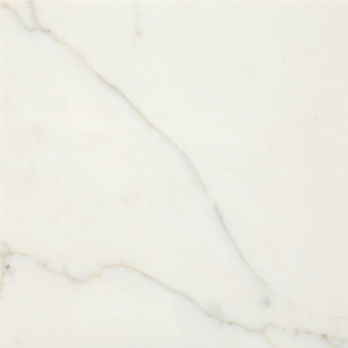Calacata Carrara
marble
Petrografic name (according EN 12407): Marble
Category: calacata
colour: white
Macroscopic description: A breccia lithotype with clasts flattened according to the schistosity planes. The material is fine-grained and compact. ivory white Millimetric opaque minerals stand out with yellow-brown veins in places associated with light brown patches. Where the veins occur, a concentration of iron oxides (pyrite) can be seen up to plurimillimetric in size.
Technical data provides a frame of reference only. As stone is a product of nature, up to date testing to determine specific physical qualities should be repeated for each major project. We decline any responsability for the mis-use of this data, since said data is sourced from the quarry.
Physical mechanical characteristics
| STANDARD | U.M. | MEAN VALUE | ST. DEV. | |
 EN 13755-08 EN 13755-08 |
Water absorption at atmospheric pressure | % | 0,1 | 0,01 |
 EN 1936-07 EN 1936-07 |
Apparent Density | KG/m3 | 2710 | 0 |
 EN 1936-07 EN 1936-07 |
Open porosity | % | 0,3 | 0,02 |
 EN 12372-07 EN 12372-07 |
Flexural strength | |||
| (in natural conditions) | MPa | 17,7 | 1,9 | |
| (EN 12371-03 exposed to 48 frost cycles | MPa | 19,4 | 2,8 | |
 EN 1926-07 EN 1926-07 |
Uniaxial compressive strength | MPa | 93,7 | 34,7 |
 EN 14231-04 EN 14231-04 |
Slip resistance (honed finishing) | |||
| (dry) | USRV | 41 | 4 | |
| (wet) | USRV | 23 | 6 | |
Block and slab characteristics
Average size of blocks: 3,00 x 1,70 x 1,70m
Slabs are preferably cut against the grain, i.e. the hard way (staggere).
 Cutting of blocks
Cutting of blocks  Surface lavoration
Surface lavoration
 Cutting of blocks
Cutting of blocks  Surface lavoration
Surface lavoration
Microscopic description according to EN 12407 e EN 12460
| A heterogeneous crystalloblastic metamorphic lithotype. The material has a crystalline mosaic structure composed of euhedral/subeuhedral calcitic blasts (from 100 to 350 Ám) with rounded or straight grain boundaries. The structure is isotropic. Rare opaque minerals and acicular muscovite are spread throughout the calcite. The veins are composed of crystalloblastic mosaics that are structurally different and up to submicroscopic in size. The form of the crystals is mainly subeuhedral with sutured grain boundaries. There are microgranulations of opaque minerals often associated with titanite that sometimes formally define the veins. There are pyritic crystals (<4 mm) with coronitic structures where the calcite can reach the maximum dimensions of 1 mm. |




